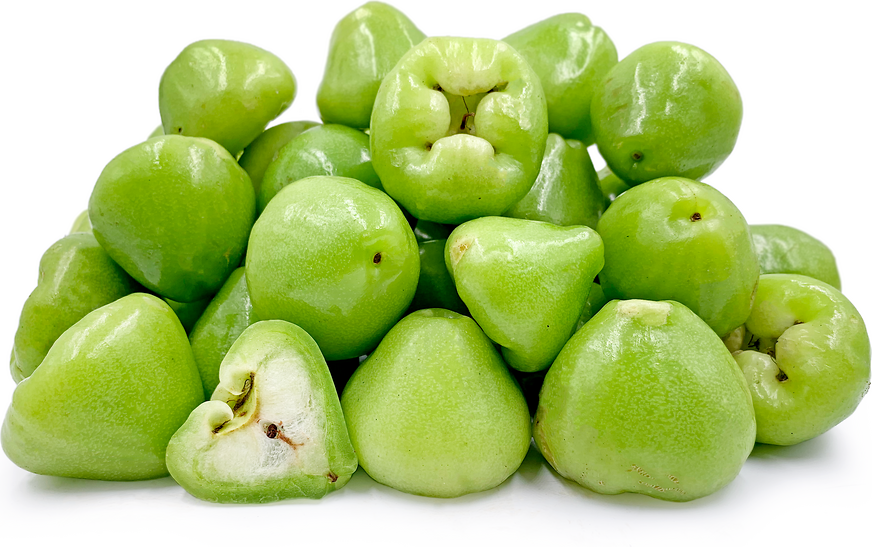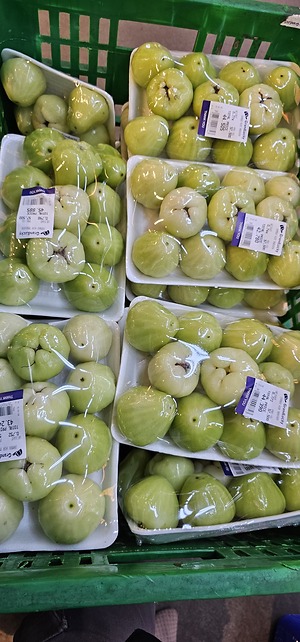


Jambu Hijau
Estimated Inventory, lb : 0
Description/Taste
Jambu Hijau is a small fruit, generally 4 to 6 centimeters in length, and has an unusual, bell-like shape with a small, curved neck that broadens into a bulbous base. The skin is smooth, glossy, thin, and pale to bright green, and at the bottom of the fruit, there are four calyx lobes. Underneath the surface, the flesh is white, crisp, semi-aqueous, and spongy with a soft, airy consistency. In the center of the flesh, there is also a light weave of white fibers that is edible but is typically discarded, and depending on the variety, the fruits may be seedless or contain a few black-brown seeds. Jambu Hijau has a neutral flavor with mild, sweet, and subtly fruity nuances.
Seasons/Availability
Jambu Hijau is available year-round in Southeast Asia.
Current Facts
Jambu Hijau, botanically classified as Syzygium aqueum, is a general descriptor for sweet, tropical fruits belonging to the Myrtaceae family. The word hijau translates from Indonesian to mean “green” and is used to describe several varieties of jambu, airy, crisp fruits, also known as water apples and rose apples. Jambu Hijau is favored throughout Southeast Asia, especially in Indonesia, for its sweet, refreshing taste and unique green skin. The fruits are primarily consumed fresh and are commonly sold through local markets, displayed in colorful piles, chopped into fruit salad, or skewered onto sticks as on-the-go street food. Jambu Hijau trees are also frequently grown in home gardens as an ornamental and culinary cultivar. The trees produce fruit multiple times a year and are fast-growing with high yields.
Nutritional Value
Jambu Hijau is an excellent source of vitamins A and C to strengthen the immune system, boost collagen production within the skin, and reduce inflammation. The fruits are also a good source of fiber to regulate the digestive tract and contain lower amounts of calcium, iron, and antioxidants.
Applications
Jambu Hijau is best suited for fresh preparations to showcase the fruit’s light, tender, and crisp texture. The fruits can be served whole and cored in decorative bowls to maintain their unique, curved shape, sometimes sprinkled with sugar and salt, or they can be eaten out of hand, and the core discarded. Jambu Hijau can also be sliced and tossed into salads or chopped and mixed into rujak, a spicy-sweet side dish. Rujak is a favored Indonesian fruit and vegetable dish that incorporates various crunchy, sweet, and tangy ingredients coated in spicy seasonings. Jambi Hijau provides added texture into rujak and complements the flavorful aromatics with its aqueous, subtly sweet flavor. Beyond salads and side dishes, Jambu Hijau can be used as a topping over desserts and main dishes, lightly sauteed for added flavor, simmered into jams, or pickled for extended use. Jambu Hijau pairs well with spices such as turmeric, mustard seeds, and curry powder, chile peppers, aromatics, including garlic, onions, ginger, lemongrass, and shallots, peanuts, and fruits such as guava, star fruit, mango, and papaya. Whole Jambu Hijau should be used immediately for the best quality and flavor. It will also keep for a couple of days when wrapped in a paper towel and stored in the refrigerator.
Ethnic/Cultural Info
In Indonesia, a relatively new type of Jambu Hijau is highly favored for commercial production and home garden cultivation. Jambu Madu Deli Hijau, also known as Jambu MDH, is a superior cultivar native to Taiwan that was brought to North Sumatra, where it was commercially produced. Jambu MDH is favored for its green skin, large size, seedless nature, and sweet flavor. The fruit averages a sugar level ranging between 12-14 Brix, giving the variety a sweeter taste than most cultivars. Jambu MDH was also registered with the Ministry of Agriculture and has become one of the most popular home garden varieties in the early 21st century. Many home gardeners value the variety for its year-round fruiting and sell the fruits in local markets as a side business. The cultivation of Jambu MDH for commercial sale is also expanding, with growers exporting the fruits to Singapore. Some commercial farms are so protective of their Jambu MDH fruit trees that walls are built around the orchard, and employees are searched every night before they go home to ensure they are not stealing cuttings of the trees.
Geography/History
Jambu Hijau is native to Southeast Asia and has been growing wild since ancient times. Farmers and breeders widely cultivate the fruit trees within their native region, but the fruits have remained relatively unknown to the rest of the world. Green varieties of jambu fruits are also still considered to be rarer than red varieties. Today Jambu Hijau is grown across Southeast Asia, especially in Indonesia, and is commercially cultivated and sown in home gardens. The fresh fruits are sold through local markets and are exported on a small scale to neighboring countries.








